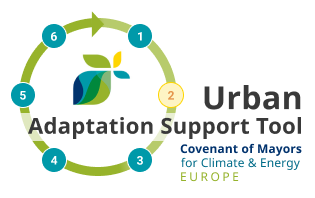
Assessing climate change risks and vulnerabilities
2.3 Identifying vulnerable urban sectors
The present and projected impacts of climate change (see Steps 2.1 and 2.2) affect the city as a whole, but some urban sectors are likely to be more affected due to their higher vulnerability or lower capacity to adapt. The ability of a given sector to adapt to and cope with climate change impacts is a function of wealth, technology, information, skills, infrastructure, institutions, equity, empowerment, and the ability to spread risk. Identifying vulnerable sectors is important to prioritise and focus the adaptation efforts.
Climate change impacts a city as a whole but some urban sectors are more vulnerable to certain climate hazards than others. For example, pluvial flooding might not directly affect public health, but can affect the transport network, causing a spill-over effects for e.g. industry. Heatwaves are probably the biggest climatic threat to health, but can also pose challenges to water and power supplies due to increased water and energy consumption.
The list of potentially vulnerable urban sectors and fields of activity to be checked in the assessment should therefore at least cover:
- Health
- Buildings
- Water
- Disaster risk management
- Transport
- Energy
- Industry
- Service sector, including Tourism
- Urban planning, including green and blue infrastructure
- Public health
- Social well-being
- Financial sector and insurance
- Environmental protection/ biodiversity
In some of the sectors, the municipality might have direct competencies and involvement, in others less so. Therefore, it is advisable to engage a wider range of sectoral stakeholders (see Step 1.6) in the assessments of sectoral vulnerabilities. It is also important to look at cross-sectoral impacts and spill-over effects among the sectors; tools such as IVAVIA may be useful to assess impact chains.
The Covenant of Mayors reporting template includes the following potentially vulnerable urban sectors that were identified based on the feedback of city practitioners: buildings, transport, energy, water, waste, land use planning, agriculture and forestry, environment and biodiversity, health, civil protection and emergency, tourism.
The impacts per sectors should be assessed along the criteria in the table below
|
Category |
Description |
|
People |
Impacts on health, workforce, communities and lifestyles |
|
Service Delivery |
Changing demand for or disruption to services delivered by the sector |
|
Infrastructure & Premises |
Impacts on buildings, roads, transport infrastructure, parks, housing maintenance and facilities management |
|
Procurement & Suppliers |
Impacts on key sub-contractors, suppliers and implications for how procurement is managed under future climate |
|
Finance |
Implications for investment and insurance |
Reports
Relevant tile
- Protecting our Capital - adaptation in cities creating resilient place for business
- Resilience of large investments and critical infrastructures in Europe to climate change
- Changes in population susceptibility to heat and cold over time: assessing adaptation to climate change
- Social vulnerability to climate change in European cities – state of play in policy and practice
